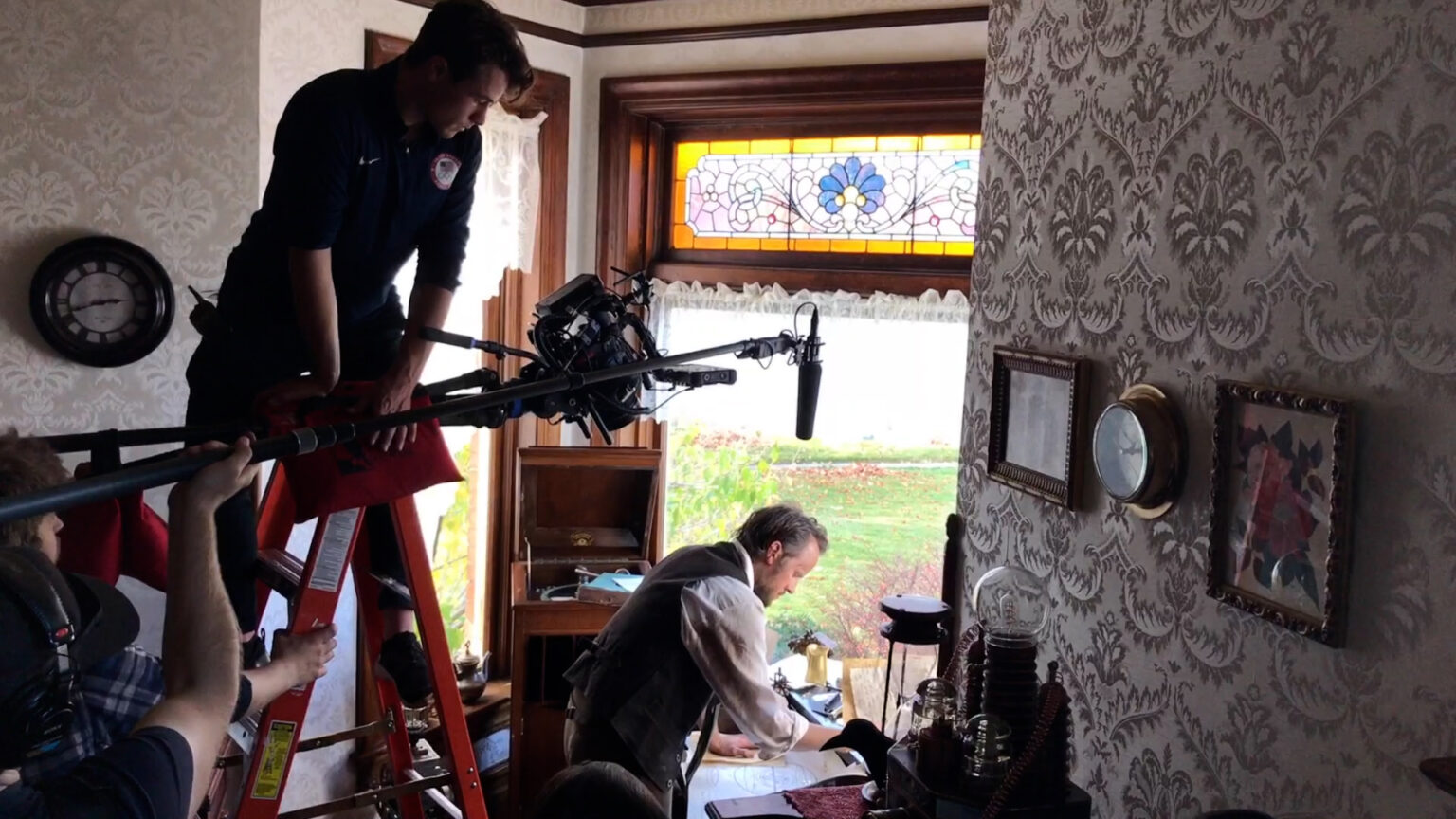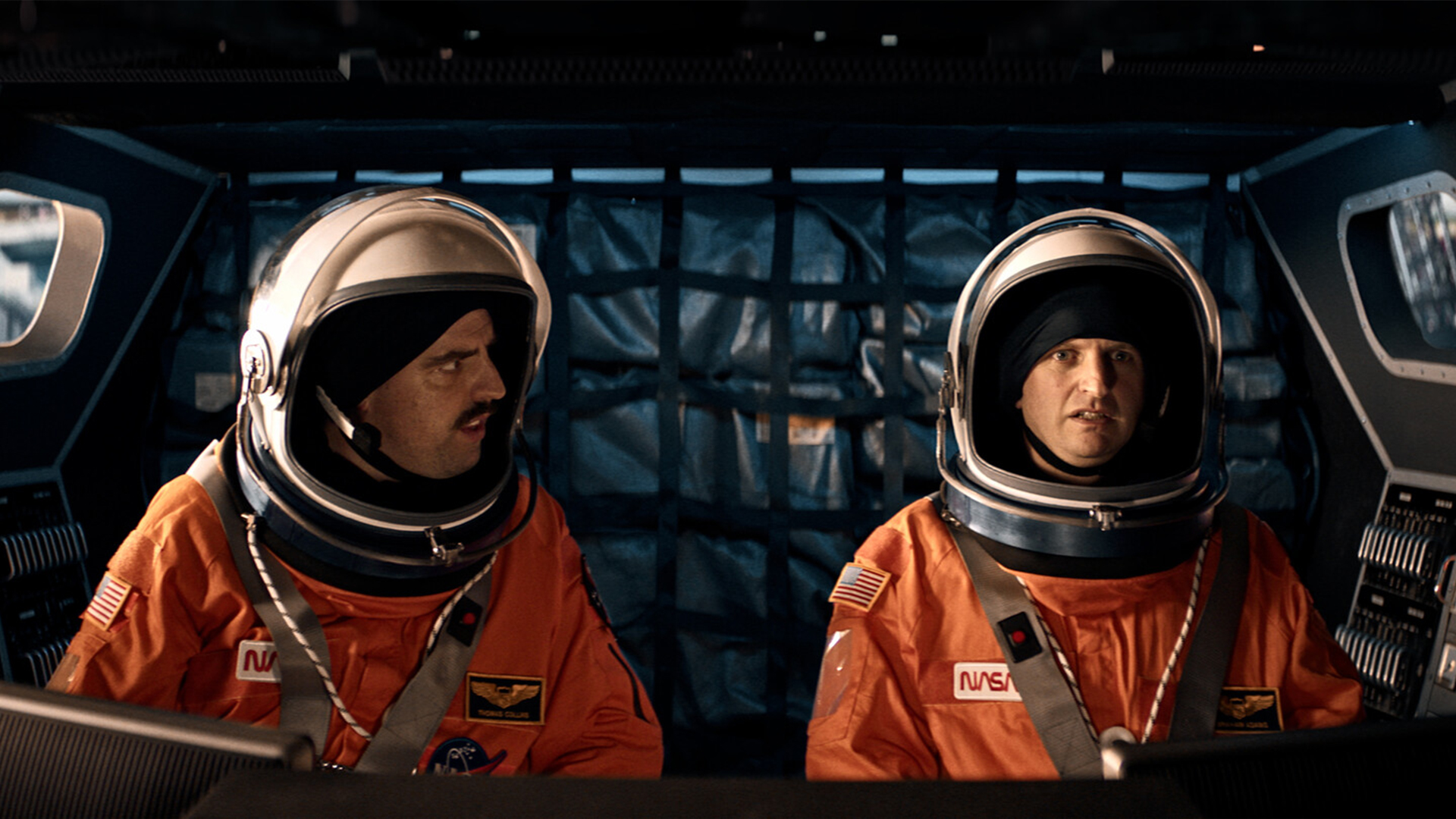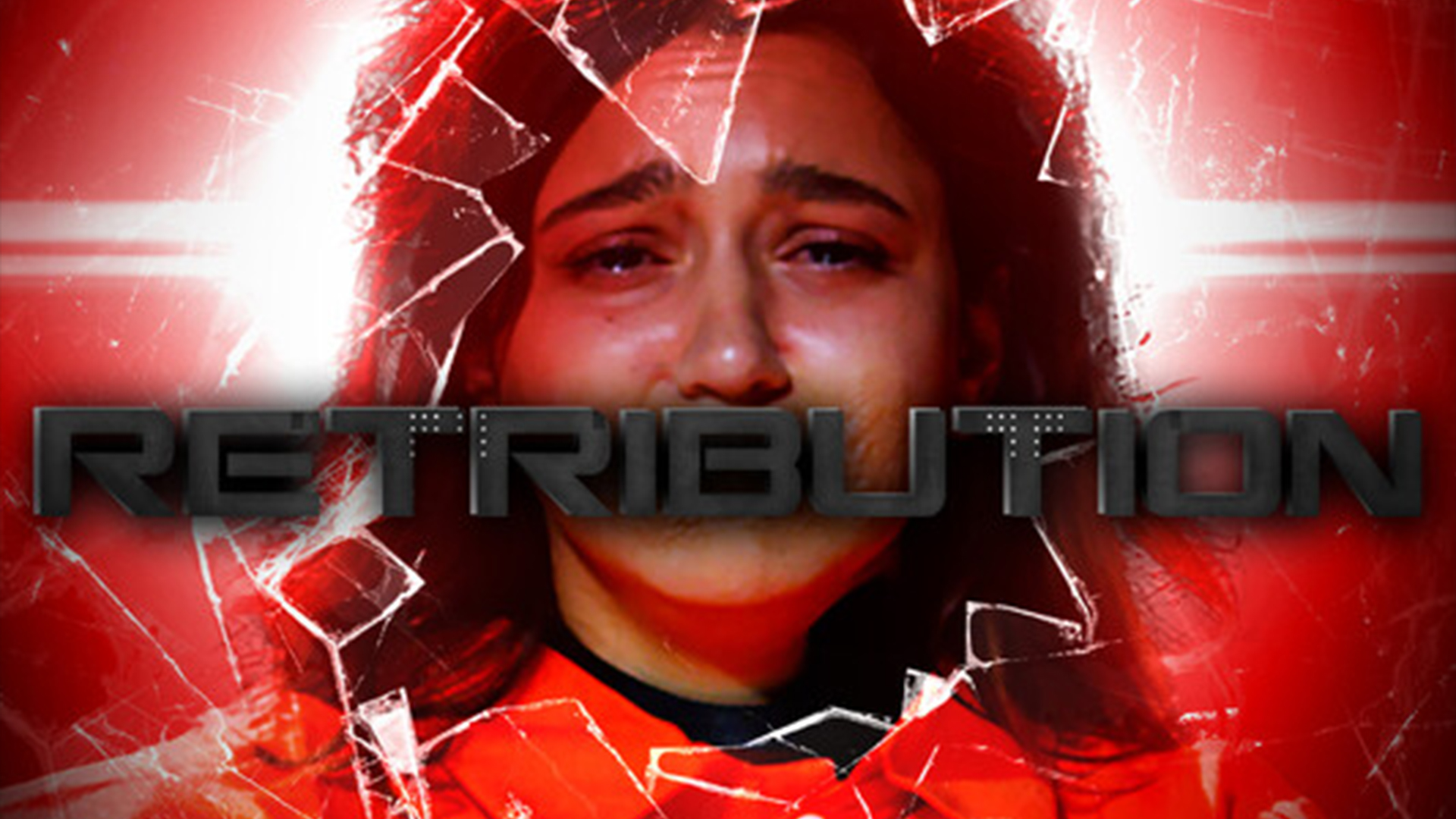Sci-Fi
The Time Machine

Ebrahim Ghaeini, the creative mind behind the short film “The Time Machine,” recently shared insights into the making of this 11-minute sci-fi gem. Adapted from H.G. Wells’ classic tale, the film invites viewers on a visual exploration of memory and time, as the Time Traveler returns to London, triggering vivid recollections of encounters with Morlocks in an underground tunnel and his unique bond with Weena, an enigmatic Eloi.
Ghaeini’s journey with “The Time Machine” began with a profound appreciation for classic literature, particularly the works of H.G. Wells, known as ‘The Father of Science Fiction.’ The film, in many ways, serves as an invitation to audiences to delve into the themes of Wells’ iconic story, hoping to ignite a curiosity that prompts viewers to pick up the original book.
““I remember feeling intrigued to dive into his novel to see where this “birth” of science fiction began,” said Ghaeini. “What captivated me the most was how the world I envisioned while reading, was a darker, dystopian world with profound societal and social commentary, in comparison to the existing film adaptations. It’s always fascinating to me when classics carry widespread recognition, yet many are unfamiliar with the story.”
“For example, most have heard of The Time Machine, 20,000 Under The Sea, Dante’s Inferno, Journey to the Center of the Earth, but what are those stories really about? What are the nuanced themes? In a way, my film serves as an invitation, encouraging audiences to explore literature and stands as a tribute to H. G. Wells – a heartfelt ‘Thank You’. It felt only appropriate to keep the film with the same title, as Wells had intended.”

Casting, a crucial element of any film, played a pivotal role in bringing Ghaeini’s vision to life. John Cave (Time Traveler) was chosen for his ability to convey authentic, multi-layered reactions without dialogue.
“John Cave, a close friend and collaborator on previous projects, stood out for his ability to deliver authentic multi-layered reactions. Johns talent came with portraying various facets of “fear” The audience will be immersed and feel fear not from what they see, but from what John perceives. When we see that John is believably afraid, we are too. He carried the film beautifully.”

Stefania Barr, who brought depth to her character Wenna, became integral parts of the storytelling.
“Her reactions on screen are genuine and powerful. I specifically sought someone who could convey ‘heart-break’ in a single gaze, and she exceeded expectations, knocking it out of the park!”

The film’s locations added another layer to its authenticity. Filming at the Heins Mansion in Provo, UT, provided the perfect Victorian atmosphere for the London house scenes. However, shooting in a storm drain at Dimple Dell Park in Sandy, UT, for the tunnel scenes brought its share of challenges, including negotiating the tunnel’s grooves, dealing with the cold November weather, and overcoming technical issues. Despite these hurdles, the end result made the efforts more than worthwhile.

“Securing film permits in parks can be challenging. Negotiating the grooves of the tunnel, avoiding rocks, and running in the dark while dealing with the cold November weather made it an immensely challenging shoot. We encountered issues like losing feed on wireless gear, dealing with water levels, covering graffiti, and even blocking the tunnel entrance at times with duvetyn. Running a generator inside was ruled out due to safety concerns and audio disturbance, so we powered through with an abundance of batteries. Despite the challenges, the base camp outside the tunnel provided some respite and warmth. This location was certainly not for the faint of heart.”

The eerie prosthetics for the Morlocks, crafted by makeup artist Julia Vinha, aimed to capture the subterranean evolution of a race envisioned by H.G. Wells.
“Months prior to filming, we collaborated extensively, examining references, conducting camera tests, and honing the right look. Our discussions focused on portraying the Morlocks as humans who had evolved over thousands of years underground, literally forming their own subterranean race, as envisioned by H.G. Wells. The prosthetics aimed to capture their pale complexion and distinctive large eyes, staying true to Wells’ description.”

Ghaeini’s filmmaking journey with “The Time Machine” proved to be a transformative experience. The decision to craft a dialogue-free film challenged him to convey the narrative solely through visuals.
“One of best pieces of advice I received was the advice to “Show, don’t tell.” Taking this to heart, I challenged myself to craft a talk-less film, relying solely on visuals to tell the narrative. Sure I had Father Wells’ guidance, but it was an invaluable learning experience.”

Beyond directing actors, he explored directing the energy of the film, considering elements such as camera motion, pacing, shot duration, and lighting.
“The Time Machine’ also served as a fun enticing exploration of the VFX world, and realizing the importance of thorough pre-visualization and preparation. These lessons are invaluable tools that I’ll undoubtedly carry forward into my future filmmaking endeavors.”

Ghaeini’s favorite aspect of the production was the collaboration with an incredible team of passionate filmmakers who became a tight-knit group of friends.
“To this day, some of us continue to celebrate Friendsgiving. There’s nothing better than creative storytelling alongside those you love and laugh with.”
As with any creative endeavor, challenges arose. The substantial pile of VFX work awaiting Ghaeini in the editing process, coupled with the role of editor, presented a stressful yet necessary learning experience.
“In hindsight, I may have been a tad over-ambitious. Managing the role of editor was already a significant task, and I further took on the responsibility of completing all the post VFX work. While it was necessary learning experience, it was an undeniably stressful process.”
For those curious about Ghaeini’s future endeavors, his website www.ebrahimghaeini.com and social media accounts, including Instagram @ebbiekg and the film’s Instagram account @thetimemachine.shortfilm , offer glimpses into his ongoing journey in the world of filmmaking.
Comedy
AstroNots

Directed by Andrew Seaton
Warning – This review may contain spoilers.
AstroNots is a short comedy that kicks off with two astronauts preparing for a crucial mission to Mars. As the montage sets the tone of urgency, things take a hilarious turn when Major Tom Collins realizes that his co-pilot, Abe, is woefully underqualified and completely unprepared for the job. Despite the gravity of their mission, Abe somehow fumbled his way through training and ended up in the co-pilot seat for the most important mission in the universe. What follows is a witty back-and-forth as they grapple with whether to proceed with the launch or abort the mission, leaving audiences in stitches with their comedic banter.
I think AstroNots nails the production design. The set was crucial for grounding the story, and it absolutely worked in creating a realistic space environment. It could’ve easily slipped into feeling corny, but the production design kept things believable while enhancing the comedy. The lighting and cinematography were on point too—using high-key lighting that matched the upbeat, comedic tone of the film. The choice to shoot from various angles kept the energy up, especially since it’s a short confined to one primary location. The editing between these different shots felt seamless, helping with pacing and keeping the visuals engaging. Sound design was another strong element, with the spaceship noises blending well with the dialogue, adding to the immersive quality of the short. Overall, from a technical standpoint, the film was spot on, and I didn’t notice any missteps.
The story itself is fun and engaging. At its core, it’s about an astronaut who takes his job very seriously and is paired with a co-pilot who absolutely shouldn’t be there. The dynamic between the two characters, played by Aaron Glenane (Abe) and Adam Dunn (Tom), worked really well. The dialogue is witty and sharp, which kept me entertained from start to finish. Despite being a 9-minute short set primarily in one location, it never felt slow or boring, which can be a challenge for this kind of setup. The ending was especially hilarious, raising a moral question that had me laughing while also thinking about what I’d do in that situation.
I think audiences will really enjoy AstroNots. The blend of humor, tight pacing, and strong performances make this an entertaining short that will likely resonate with anyone who loves a good space comedy. The film delivers a memorable experience in a short amount of time, and I’d definitely recommend it for a fun watch!
Sci-Fi
Morbid Sight

Written by A.J. Moss
Warning – This review contain spoilers.
Morbid Sight follows Sarah, a young woman with the unsettling ability to see 30 seconds into the future. Struggling with this unwanted power, Sarah seeks help from her cousin Clare, a psychiatrist who is also navigating her own troubles after the death of her father. The screenplay explores the complexities of their relationship as Clare attempts to explain away Sarah’s visions as mere intrusive thoughts born out of trauma. However, Sarah’s ability presents itself in a way that continually challenges Clare’s professional understanding and puts the tension between science and the supernatural at the forefront.
The story revolves around Sarah’s desperate need to escape from her visions, which have become more of a curse than a gift. Clare, trying to balance her professional duties with her personal struggles, offers a more grounded perspective, but as the story unfolds, it becomes clear that both women are trapped in their own forms of turmoil. The pacing of the screenplay is driven by suspense, with hints of psychological tension that keep the audience engaged, especially as Sarah’s visions intensify and lead toward a tragic, yet somewhat predictable, climax. The presence of a firearm early on foreshadows Sarah’s eventual demise, though the final twist involving Clare inheriting Sarah’s ability adds an interesting wrinkle to the narrative.
While the screenplay’s concept is intriguing, the execution could use more dynamism, particularly in how Sarah’s ability is portrayed. The ability to see 30 seconds into the future is visually and conceptually rich, but it isn’t used in as engaging or inventive a way as it could be. The story often feels more told than shown, with long stretches of dialogue that slow the momentum. The characters’ lines, while clear, could be more distinct and tailored to their individual personalities, as they sometimes feel interchangeable. That said, the psychological depth of the story, particularly the tension between the cousins, holds potential and could be further fleshed out in future drafts.
On a technical level, Morbid Sight is mostly polished. The main area for improvement lies in scene structure and pacing, as certain scenes and monologues feel unnecessarily drawn out. Action lines and character positioning also occasionally lack clarity, making it harder for the reader to follow the flow of the action.
Morbid Sight is an engaging psychological thriller. At only 12 pages long the screenplay packs a lot in a little amount of time. I would be interested to see what A.J. Moss can build on if he was to expanded the script into a feature to explore more of Sarah’s world.
Drama
Retribution

Directed by Brock Eastwood
Warning – This review contains spoilers
My popcorn was all buttered up and I was set to check out Brock Eastwood’s Retribution when I found myself drawn into its intriguing dystopian premise. Set in a future world where therapeutic treatments are disguised as punishments for society’s criminals, the film tackles some big questions about morality, memory, and the consequences of an authoritarian system. The story centers around Nicholas (played by Dane Keckley), a young man seeking redemption or perhaps simply closure after a traumatic experience. He undergoes a novel “treatment” at a futuristic clinic, hoping to address the guilt and pain from losing someone he loved, only to discover that the process has darker implications.
One of the strengths of Retribution lies in the way it gradually reveals its world. At first, I wasn’t quite sure where the story was headed, but small details hinted at the dystopian nature of the society. The AI-enforced curfews, the rigid controls, and the dehumanizing clinical treatment all come together to paint a picture of a future that feels both frighteningly real and disorienting. The concept reminded me of films like Eternal Sunshine of the Spotless Mind and 1984, especially in how it explores memory manipulation as a form of control. The comparison to Logan’s Run is also apt, given the film’s themes of life, death, and rebellion against a system that punishes those who step out of line.
Technically, the film had a few highs and lows. The cinematography, particularly in the outdoor scenes, was beautifully shot. There’s a sunset transition that felt genuinely poetic, adding a layer of emotional depth to the moment between Nicholas and Merin (Avery Pizzuto). However, the lighting in some interior scenes felt overexposed, making certain moments feel too harsh for the emotional weight they were trying to carry. Sound design was mostly solid, though I did notice some unclear dialogue in the opening scene, which could have benefited from a cleaner mix. Despite these minor issues, I thought the editing in key moments, especially the reveal of Nicholas’ memories, worked really well. The timing of these cuts built tension effectively, particularly as the film reached its emotional climax.
What fascinated me most about Retribution was its exploration of grief and memory. Nicholas is clearly haunted by the death of Merin, and the clinic offers him a chance to relive, if not alter, those painful memories. There’s something inherently tragic about a world where even our most intimate memories can be subject to manipulation. The twist near the end caught me off guard, although in hindsight, it felt inevitable. That unanswered mystery left me unsettled in a good way. It’s the kind of ambiguity that prompts further reflection.
I did feel the film could have been clearer in its world-building. Some of the dystopian elements, like why Merin died while Nicholas survived or the exact nature of the clinic’s purpose, weren’t fully fleshed out. These gaps in the narrative left me feeling slightly adrift, especially toward the end when the lines between reality and memory blur completely. The ending, while effective in its jarring nature, raised more questions than it answered. Why did Merin ultimately turn on Nicholas? Was it part of the “treatment” or something deeper within their relationship that we missed? These ambiguities could be intentional, but I found myself wishing for just a bit more clarity.
That said, I think audiences will appreciate Retribution for its ambitious storytelling and the questions it raises about memory, justice, and personal responsibility. The performances, particularly from Keckley and Pizzuto, were strong, with both actors delivering emotional depth in scenes that required subtlety. I also found the production design impressive, especially the use of minimalist, sterile environments in the clinic scenes, which heightened the cold, clinical feel of the dystopian world.
Retribution is a thought-provoking short film that, despite some narrative hiccups, offers a compelling look at how we process grief and guilt in a society that seeks to control even our memories. Fans of dystopian sci-fi and psychological thrillers will likely find much to enjoy here, especially in its exploration of love, loss, and the dangers of a system that prioritizes punishment over healing. It left me with a lot to think about—and in my book, that’s always a sign of a film that succeeds in leaving a lasting impact.










